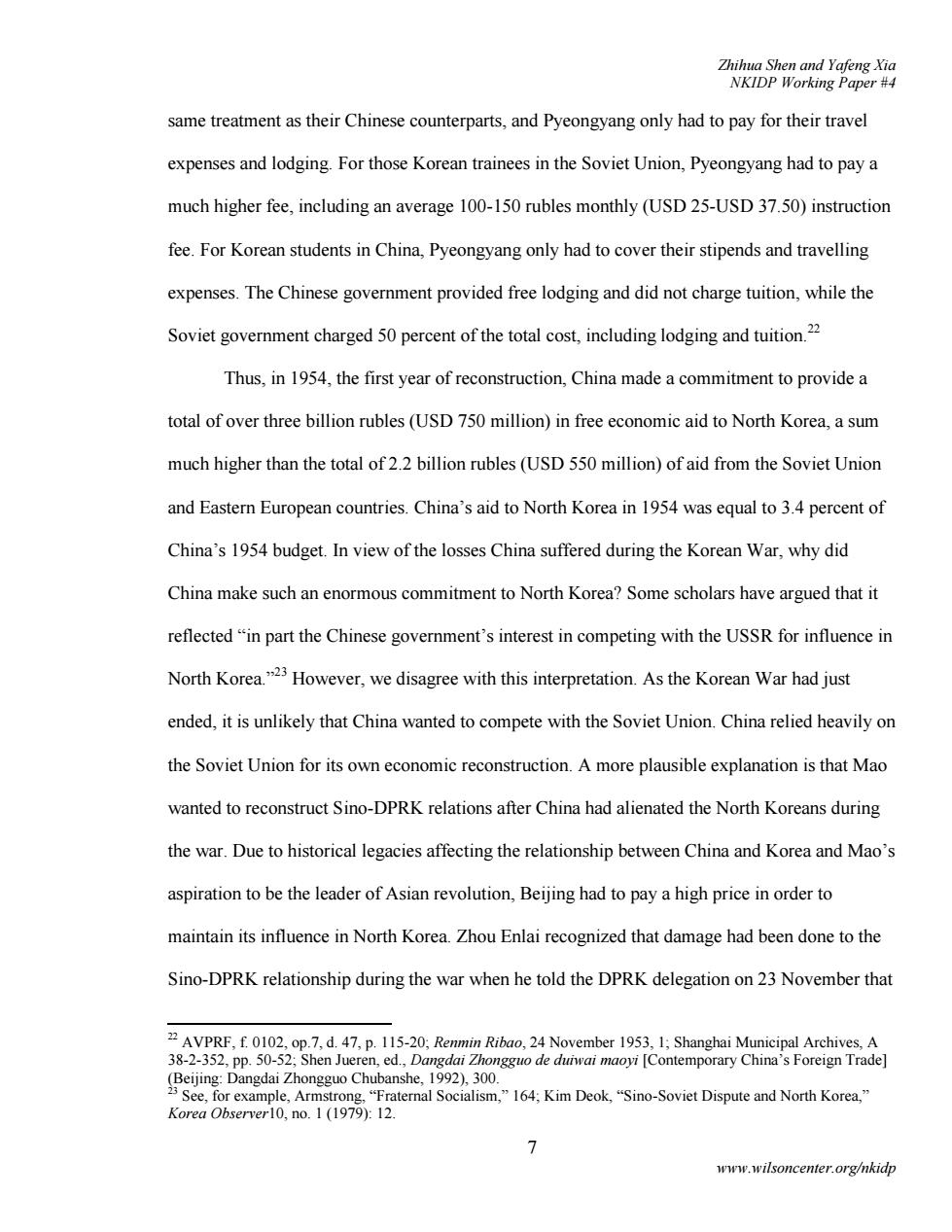
Zhihua Shen and Yafeng Xia NKIDP Working Paper #4 same treatment as their Chinese counterparts,and Pyeongyang only had to pay for their travel expenses and lodging.For those Korean trainees in the Soviet Union,Pyeongyang had to pay a much higher fee,including an average 100-150 rubles monthly (USD 25-USD 37.50)instruction fee.For Korean students in China,Pyeongyang only had to cover their stipends and travelling expenses.The Chinese government provided free lodging and did not charge tuition,while the Soviet government charged 50 percent of the total cost,including lodging and tuition.22 Thus,in 1954,the first year of reconstruction,China made a commitment to provide a total of over three billion rubles(USD 750 million)in free economic aid to North Korea,a sum much higher than the total of 2.2 billion rubles(USD 550 million)of aid from the Soviet Union and Eastern European countries.China's aid to North Korea in 1954 was equal to 3.4 percent of China's 1954 budget.In view of the losses China suffered during the Korean War,why did China make such an enormous commitment to North Korea?Some scholars have argued that it reflected"in part the Chinese government's interest in competing with the USSR for influence in North Korea."23 However,we disagree with this interpretation.As the Korean War had just ended,it is unlikely that China wanted to compete with the Soviet Union.China relied heavily on the Soviet Union for its own economic reconstruction.A more plausible explanation is that Mao wanted to reconstruct Sino-DPRK relations after China had alienated the North Koreans during the war.Due to historical legacies affecting the relationship between China and Korea and Mao's aspiration to be the leader of Asian revolution,Beijing had to pay a high price in order to maintain its influence in North Korea.Zhou Enlai recognized that damage had been done to the Sino-DPRK relationship during the war when he told the DPRK delegation on 23 November that 2AVPRF,f12op.,d.47,p.115-20;Renmin Ribao,24 November 193,1:Shanghai Municipal Archives.A 38-2-352,pp.50-52;Shen Jueren,ed.,Dangdai Zhongguo de duiwai maoyi [Contemporary China's Foreign Trade] (Beijing:Dangdai Zhongguo Chubanshe,1992).300. 23 See,for example,Armstrong,"Fraternal Socialism,"164;Kim Deok,"Sino-Soviet Dispute and North Korea," Korea Observer10,no.1(1979):12. 7 www.wilsoncenter.org/nkidp
Zhihua Shen and Yafeng Xia NKIDP Working Paper #4 7 www.wilsoncenter.org/nkidp same treatment as their Chinese counterparts, and Pyeongyang only had to pay for their travel expenses and lodging. For those Korean trainees in the Soviet Union, Pyeongyang had to pay a much higher fee, including an average 100-150 rubles monthly (USD 25-USD 37.50) instruction fee. For Korean students in China, Pyeongyang only had to cover their stipends and travelling expenses. The Chinese government provided free lodging and did not charge tuition, while the Soviet government charged 50 percent of the total cost, including lodging and tuition.22 Thus, in 1954, the first year of reconstruction, China made a commitment to provide a total of over three billion rubles (USD 750 million) in free economic aid to North Korea, a sum much higher than the total of 2.2 billion rubles (USD 550 million) of aid from the Soviet Union and Eastern European countries. China’s aid to North Korea in 1954 was equal to 3.4 percent of China’s 1954 budget. In view of the losses China suffered during the Korean War, why did China make such an enormous commitment to North Korea? Some scholars have argued that it reflected “in part the Chinese government’s interest in competing with the USSR for influence in North Korea.”23 However, we disagree with this interpretation. As the Korean War had just ended, it is unlikely that China wanted to compete with the Soviet Union. China relied heavily on the Soviet Union for its own economic reconstruction. A more plausible explanation is that Mao wanted to reconstruct Sino-DPRK relations after China had alienated the North Koreans during the war. Due to historical legacies affecting the relationship between China and Korea and Mao’s aspiration to be the leader of Asian revolution, Beijing had to pay a high price in order to maintain its influence in North Korea. Zhou Enlai recognized that damage had been done to the Sino-DPRK relationship during the war when he told the DPRK delegation on 23 November that 22 AVPRF, f. 0102, op.7, d. 47, p. 115-20; Renmin Ribao, 24 November 1953, 1; Shanghai Municipal Archives, A 38-2-352, pp. 50-52; Shen Jueren, ed., Dangdai Zhongguo de duiwai maoyi [Contemporary China’s Foreign Trade] (Beijing: Dangdai Zhongguo Chubanshe, 1992), 300. 23 See, for example, Armstrong, “Fraternal Socialism,” 164; Kim Deok, “Sino-Soviet Dispute and North Korea,” Korea Observer10, no. 1 (1979): 12
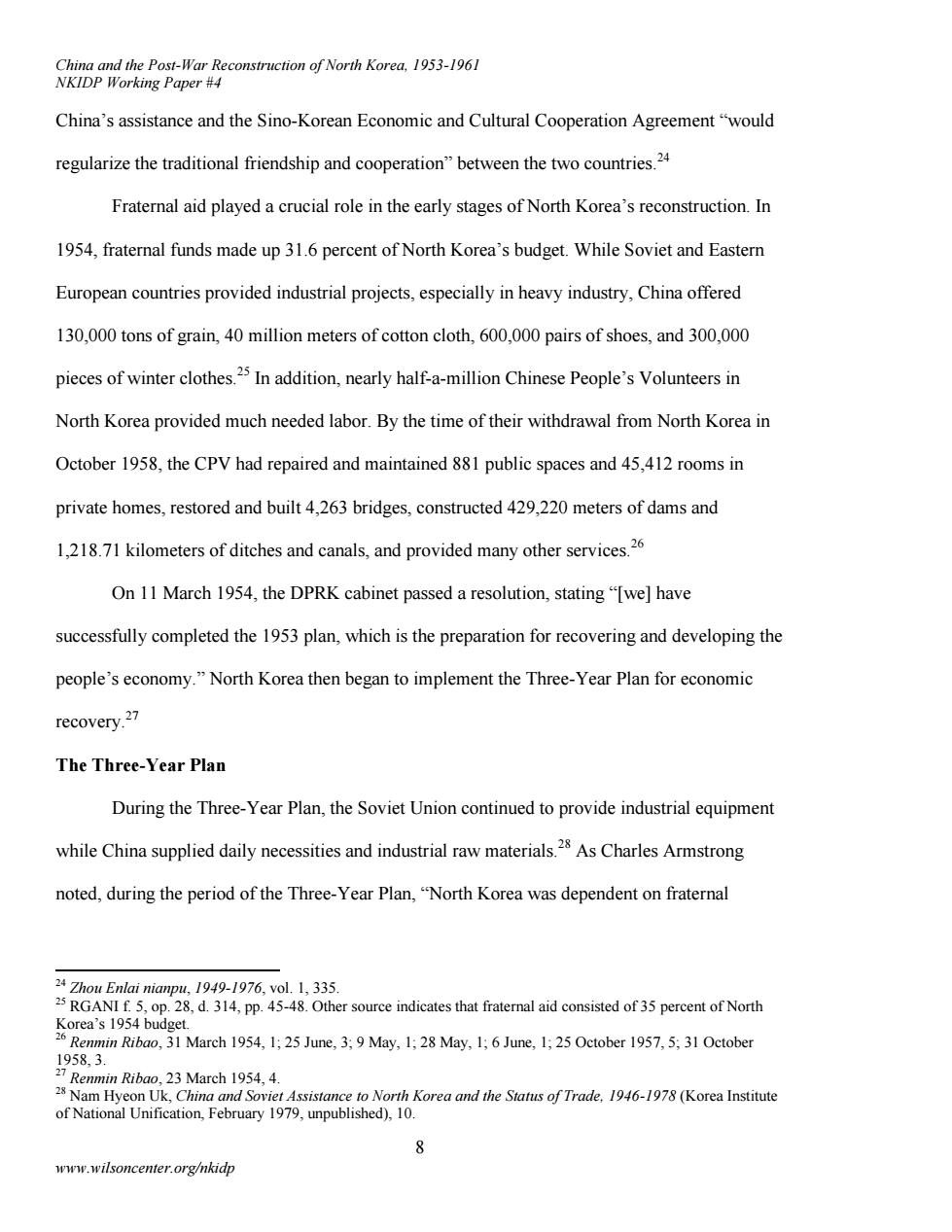
China and the Post-War Reconstruction of North Korea,1953-1961 NKIDP Working Paper #4 China's assistance and the Sino-Korean Economic and Cultural Cooperation Agreement "would regularize the traditional friendship and cooperation"between the two countries.24 Fraternal aid played a crucial role in the early stages of North Korea's reconstruction.In 1954,fraternal funds made up 31.6 percent of North Korea's budget.While Soviet and Eastern European countries provided industrial projects,especially in heavy industry,China offered 130,000 tons of grain,40 million meters of cotton cloth,600,000 pairs of shoes,and 300,000 pieces of winter clothes.5In addition,nearly half-a-million Chinese People's Volunteers in North Korea provided much needed labor.By the time of their withdrawal from North Korea in October 1958,the CPV had repaired and maintained 881 public spaces and 45,412 rooms in private homes,restored and built 4,263 bridges,constructed 429,220 meters of dams and 1,218.71 kilometers of ditches and canals,and provided many other services.26 On 11 March 1954,the DPRK cabinet passed a resolution,stating"[we]have successfully completed the 1953 plan,which is the preparation for recovering and developing the people's economy."North Korea then began to implement the Three-Year Plan for economic recovery.27 The Three-Year Plan During the Three-Year Plan,the Soviet Union continued to provide industrial equipment while China supplied daily necessities and industrial raw materials.2 As Charles Armstrong noted,during the period of the Three-Year Plan,"North Korea was dependent on fraternal 24 Zhou Enlai nianpu,1949-1976,vol.1,335. 25 RGANI f.5,op.28,d.314,pp.45-48.Other source indicates that fraternal aid consisted of 35 percent of North Korea's 1954 budget. 26 Renmin Ribao,31 March 1954,1;25 June,3;9 May,1;28 May,1;6 June,1;25 October 1957,5;31 October 1958,3. 27 Renmin Ribao,23 March 1954,4. 2Nam Hyeon Uk,China and Soviet Assistance to North Korea and the Status of Trade,1946-1978(Korea Institute of National Unification,February 1979,unpublished),10. 8 www.wilsoncenter.org/nkidp
China and the Post-War Reconstruction of North Korea, 1953-1961 NKIDP Working Paper #4 8 www.wilsoncenter.org/nkidp China’s assistance and the Sino-Korean Economic and Cultural Cooperation Agreement “would regularize the traditional friendship and cooperation” between the two countries.24 Fraternal aid played a crucial role in the early stages of North Korea’s reconstruction. In 1954, fraternal funds made up 31.6 percent of North Korea’s budget. While Soviet and Eastern European countries provided industrial projects, especially in heavy industry, China offered 130,000 tons of grain, 40 million meters of cotton cloth, 600,000 pairs of shoes, and 300,000 pieces of winter clothes.25 In addition, nearly half-a-million Chinese People’s Volunteers in North Korea provided much needed labor. By the time of their withdrawal from North Korea in October 1958, the CPV had repaired and maintained 881 public spaces and 45,412 rooms in private homes, restored and built 4,263 bridges, constructed 429,220 meters of dams and 1,218.71 kilometers of ditches and canals, and provided many other services.26 On 11 March 1954, the DPRK cabinet passed a resolution, stating “[we] have successfully completed the 1953 plan, which is the preparation for recovering and developing the people’s economy.” North Korea then began to implement the Three-Year Plan for economic recovery.27 The Three-Year Plan During the Three-Year Plan, the Soviet Union continued to provide industrial equipment while China supplied daily necessities and industrial raw materials.28 As Charles Armstrong noted, during the period of the Three-Year Plan, “North Korea was dependent on fraternal 24 Zhou Enlai nianpu, 1949-1976, vol. 1, 335. 25 RGANI f. 5, op. 28, d. 314, pp. 45-48. Other source indicates that fraternal aid consisted of 35 percent of North Korea’s 1954 budget. 26 Renmin Ribao, 31 March 1954, 1; 25 June, 3; 9 May, 1; 28 May, 1; 6 June, 1; 25 October 1957, 5; 31 October 1958, 3. 27 Renmin Ribao, 23 March 1954, 4. 28 Nam Hyeon Uk, China and Soviet Assistance to North Korea and the Status of Trade, 1946-1978 (Korea Institute of National Unification, February 1979, unpublished), 10
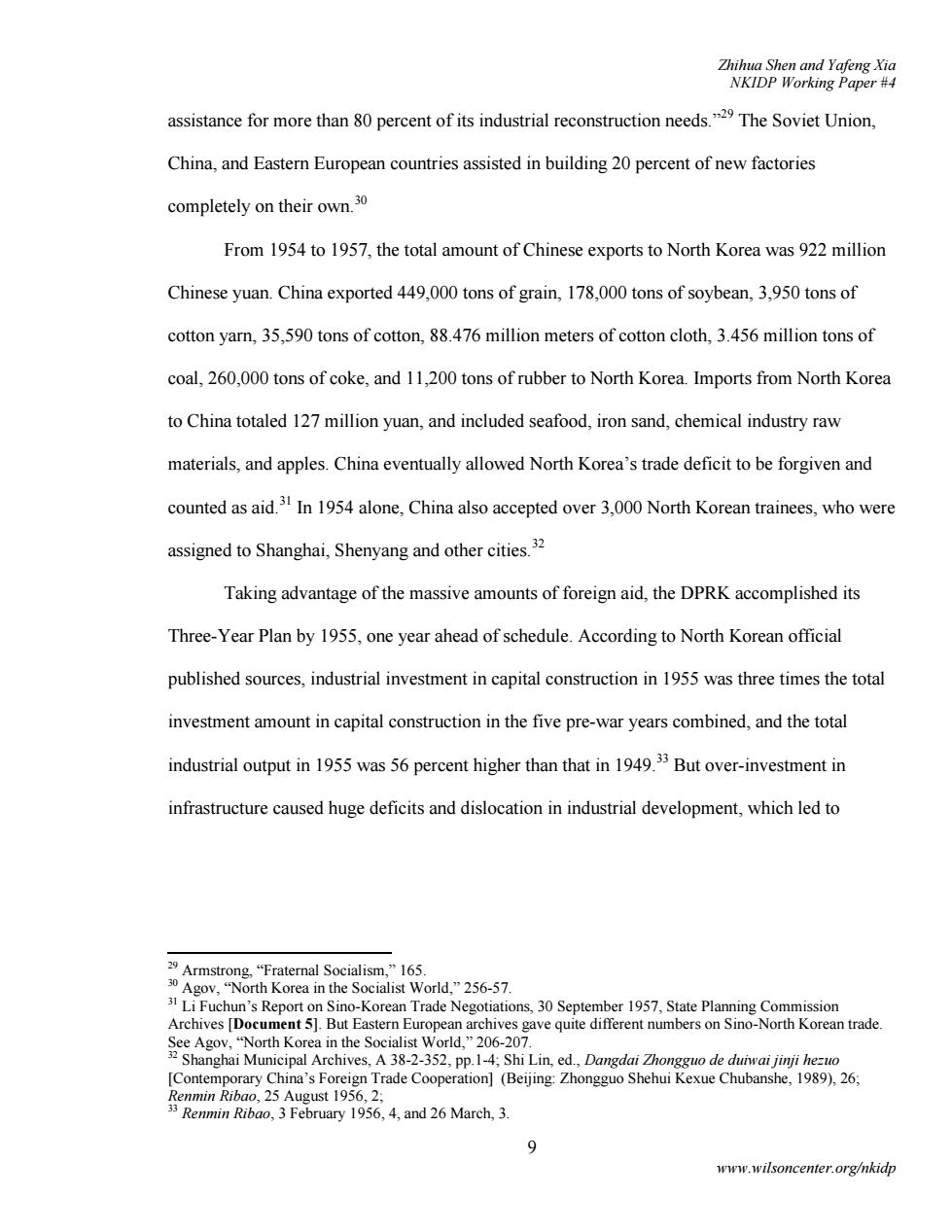
Zhihua Shen and Yafeng Xia NKIDP Working Paper #4 assistance for more than 80 percent of its industrial reconstruction needs.The Soviet Union, China,and Eastern European countries assisted in building 20 percent of new factories completely on their own.30 From 1954 to 1957,the total amount of Chinese exports to North Korea was 922 million Chinese yuan.China exported 449,000 tons of grain,178,000 tons of soybean,3,950 tons of cotton yarn,35,590 tons of cotton,88.476 million meters of cotton cloth,3.456 million tons of coal,260,000 tons of coke,and 11,200 tons of rubber to North Korea.Imports from North Korea to China totaled 127 million yuan,and included seafood,iron sand,chemical industry raw materials,and apples.China eventually allowed North Korea's trade deficit to be forgiven and counted as aid.3!In 1954 alone,China also accepted over 3,000 North Korean trainees,who were assigned to Shanghai,Shenyang and other cities.32 Taking advantage of the massive amounts of foreign aid,the DPRK accomplished its Three-Year Plan by 1955,one year ahead of schedule.According to North Korean official published sources,industrial investment in capital construction in 1955 was three times the total investment amount in capital construction in the five pre-war years combined,and the total industrial output in 1955 was 56 percent higher than that in 1949.33 But over-investment in infrastructure caused huge deficits and dislocation in industrial development,which led to 29 Armstrong,"Fraternal Socialism,"165. Agov,"North Korea in the Socialist World,"256-57. 31 Li Fuchun's Report on Sino-Korean Trade Negotiations,30 September 1957,State Planning Commission Archives [Document 5].But Eastern European archives gave quite different numbers on Sino-North Korean trade. See Agov,"North Korea in the Socialist World,"206-207. Shanghai Municipal Archives,A38-2-352.pp.1-4:Shi Lin,ed.Dangdai Zhongguo de duiwai jinji heo [Contemporary China's Foreign Trade Cooperation](Beijing:Zhongguo Shehui Kexue Chubanshe,1989),26; Renmin Ribao,25 August 1956,2; 33 Renmin Ribao,3 February 1956,4,and 26 March,3. 9 www.wilsoncenter.org/nkidp
Zhihua Shen and Yafeng Xia NKIDP Working Paper #4 9 www.wilsoncenter.org/nkidp assistance for more than 80 percent of its industrial reconstruction needs.”29 The Soviet Union, China, and Eastern European countries assisted in building 20 percent of new factories completely on their own.30 From 1954 to 1957, the total amount of Chinese exports to North Korea was 922 million Chinese yuan. China exported 449,000 tons of grain, 178,000 tons of soybean, 3,950 tons of cotton yarn, 35,590 tons of cotton, 88.476 million meters of cotton cloth, 3.456 million tons of coal, 260,000 tons of coke, and 11,200 tons of rubber to North Korea. Imports from North Korea to China totaled 127 million yuan, and included seafood, iron sand, chemical industry raw materials, and apples. China eventually allowed North Korea’s trade deficit to be forgiven and counted as aid.31 In 1954 alone, China also accepted over 3,000 North Korean trainees, who were assigned to Shanghai, Shenyang and other cities.32 Taking advantage of the massive amounts of foreign aid, the DPRK accomplished its Three-Year Plan by 1955, one year ahead of schedule. According to North Korean official published sources, industrial investment in capital construction in 1955 was three times the total investment amount in capital construction in the five pre-war years combined, and the total industrial output in 1955 was 56 percent higher than that in 1949.33 But over-investment in infrastructure caused huge deficits and dislocation in industrial development, which led to 29 Armstrong, “Fraternal Socialism,” 165. 30 Agov, “North Korea in the Socialist World,” 256-57. 31 Li Fuchun’s Report on Sino-Korean Trade Negotiations, 30 September 1957, State Planning Commission Archives [Document 5]. But Eastern European archives gave quite different numbers on Sino-North Korean trade. See Agov, “North Korea in the Socialist World,” 206-207. 32 Shanghai Municipal Archives, A 38-2-352, pp.1-4; Shi Lin, ed., Dangdai Zhongguo de duiwai jinji hezuo [Contemporary China’s Foreign Trade Cooperation] (Beijing: Zhongguo Shehui Kexue Chubanshe, 1989), 26; Renmin Ribao, 25 August 1956, 2; 33 Renmin Ribao, 3 February 1956, 4, and 26 March, 3
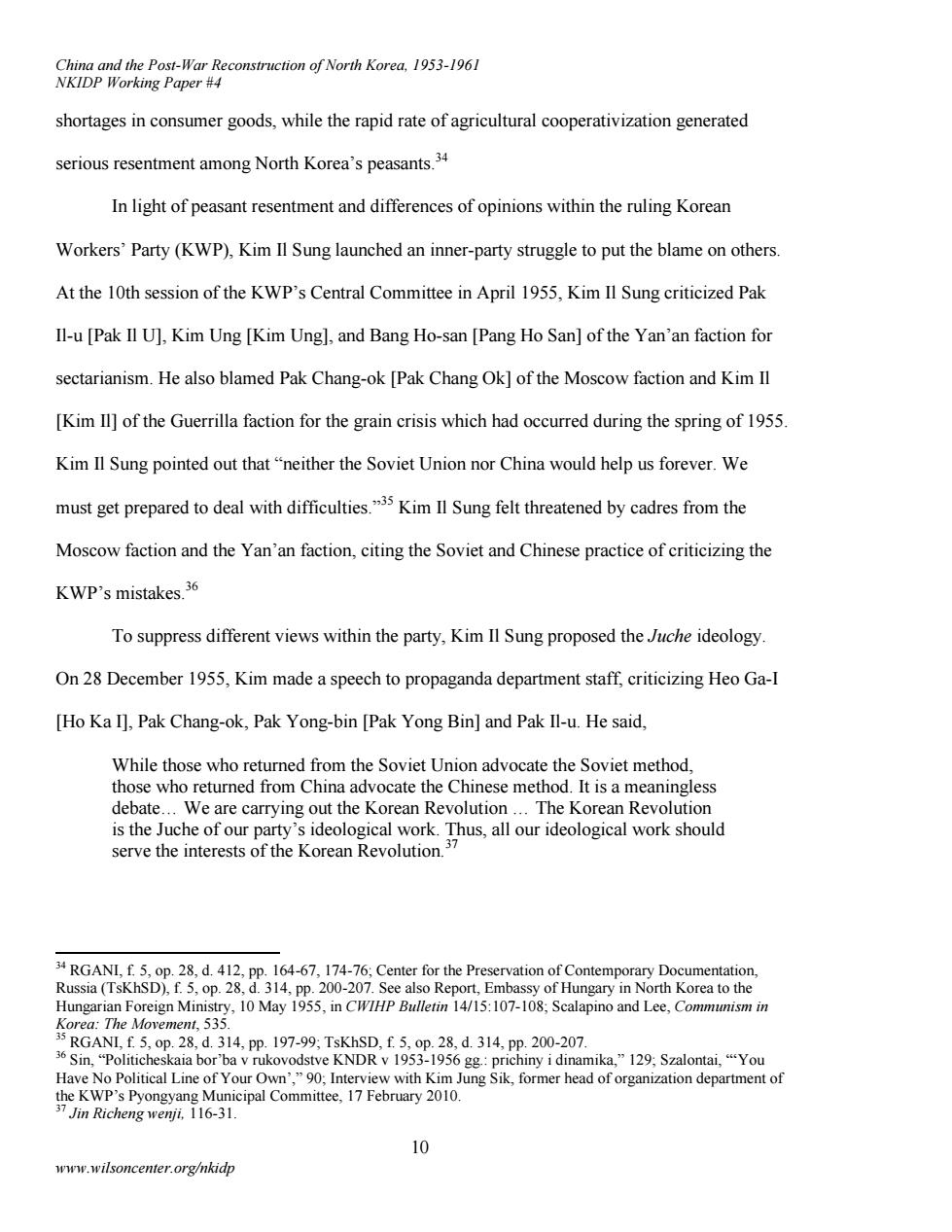
China and the Post-War Reconstruction of North Korea,1953-1961 NKIDP Working Paper #4 shortages in consumer goods,while the rapid rate of agricultural cooperativization generated serious resentment among North Korea's peasants.34 In light of peasant resentment and differences of opinions within the ruling Korean Workers'Party(KWP),Kim Il Sung launched an inner-party struggle to put the blame on others. At the 10th session of the KWP's Central Committee in April 1955,Kim Il Sung criticized Pak Il-u [Pak Il U],Kim Ung [Kim Ung],and Bang Ho-san [Pang Ho San]of the Yan'an faction for sectarianism.He also blamed Pak Chang-ok [Pak Chang Ok]of the Moscow faction and Kim Il [Kim Il]of the Guerrilla faction for the grain crisis which had occurred during the spring of 1955 Kim Il Sung pointed out that"neither the Soviet Union nor China would help us forever.We must get prepared to deal with difficulties."3 Kim Il Sung felt threatened by cadres from the Moscow faction and the Yan'an faction,citing the Soviet and Chinese practice of criticizing the KWP's mistakes.36 To suppress different views within the party,Kim Il Sung proposed the Juche ideology. On 28 December 1955,Kim made a speech to propaganda department staff,criticizing Heo Ga-I [Ho Ka I],Pak Chang-ok,Pak Yong-bin Pak Yong Bin]and Pak Il-u.He said, While those who returned from the Soviet Union advocate the Soviet method, those who returned from China advocate the Chinese method.It is a meaningless debate...We are carrying out the Korean Revolution...The Korean Revolution is the Juche of our party's ideological work.Thus,all our ideological work should serve the interests of the Korean Revolution. 37 34 RGANI,f.5,op.28,d.412,pp.164-67,174-76;Center for the Preservation of Contemporary Documentation, Russia(TsKhSD),f.5,op.28,d.314,pp.200-207.See also Report,Embassy of Hungary in North Korea to the Hungarian Foreign Ministry,10 May 1955,in CWIHP Bulletin 14/15:107-108;Scalapino and Lee,Communism in Korea:The Movement,535. 5 RGANI,f5,op.28,d.314,Ppp.197-99:TsKhSD,f5,op.28,d.314,pp.200-207. Sin,"Politicheskaia bor'ba vrukovodstve KNDRv1953-1956 gg:prichiny i dinamika,"129 Szalontai,You Have No Political Line of Your Own',"90;Interview with Kim Jung Sik,former head of organization department of the KWP's Pyongyang Municipal Committee,17 February 2010. 37 Jin Richeng wenji,116-31. 10 www.wilsoncenter.org/nkidp
China and the Post-War Reconstruction of North Korea, 1953-1961 NKIDP Working Paper #4 10 www.wilsoncenter.org/nkidp shortages in consumer goods, while the rapid rate of agricultural cooperativization generated serious resentment among North Korea’s peasants. 34 In light of peasant resentment and differences of opinions within the ruling Korean Workers’ Party (KWP), Kim Il Sung launched an inner-party struggle to put the blame on others. At the 10th session of the KWP’s Central Committee in April 1955, Kim Il Sung criticized Pak Il-u [Pak Il U], Kim Ung [Kim Ung], and Bang Ho-san [Pang Ho San] of the Yan’an faction for sectarianism. He also blamed Pak Chang-ok [Pak Chang Ok] of the Moscow faction and Kim Il [Kim Il] of the Guerrilla faction for the grain crisis which had occurred during the spring of 1955. Kim Il Sung pointed out that “neither the Soviet Union nor China would help us forever. We must get prepared to deal with difficulties.”35 Kim Il Sung felt threatened by cadres from the Moscow faction and the Yan’an faction, citing the Soviet and Chinese practice of criticizing the KWP’s mistakes.36 To suppress different views within the party, Kim Il Sung proposed the Juche ideology. On 28 December 1955, Kim made a speech to propaganda department staff, criticizing Heo Ga-I [Ho Ka I], Pak Chang-ok, Pak Yong-bin [Pak Yong Bin] and Pak Il-u. He said, While those who returned from the Soviet Union advocate the Soviet method, those who returned from China advocate the Chinese method. It is a meaningless debate… We are carrying out the Korean Revolution … The Korean Revolution is the Juche of our party’s ideological work. Thus, all our ideological work should serve the interests of the Korean Revolution.37 34 RGANI, f. 5, op. 28, d. 412, pp. 164-67, 174-76; Center for the Preservation of Contemporary Documentation, Russia (TsKhSD), f. 5, op. 28, d. 314, pp. 200-207. See also Report, Embassy of Hungary in North Korea to the Hungarian Foreign Ministry, 10 May 1955, in CWIHP Bulletin 14/15:107-108; Scalapino and Lee, Communism in Korea: The Movement, 535. 35 RGANI, f. 5, op. 28, d. 314, pp. 197-99; TsKhSD, f. 5, op. 28, d. 314, pp. 200-207. 36 Sin, “Politicheskaia bor’ba v rukovodstve KNDR v 1953-1956 gg.: prichiny i dinamika,” 129; Szalontai, “‘You Have No Political Line of Your Own’,” 90; Interview with Kim Jung Sik, former head of organization department of the KWP’s Pyongyang Municipal Committee, 17 February 2010. 37 Jin Richeng wenji, 116-31
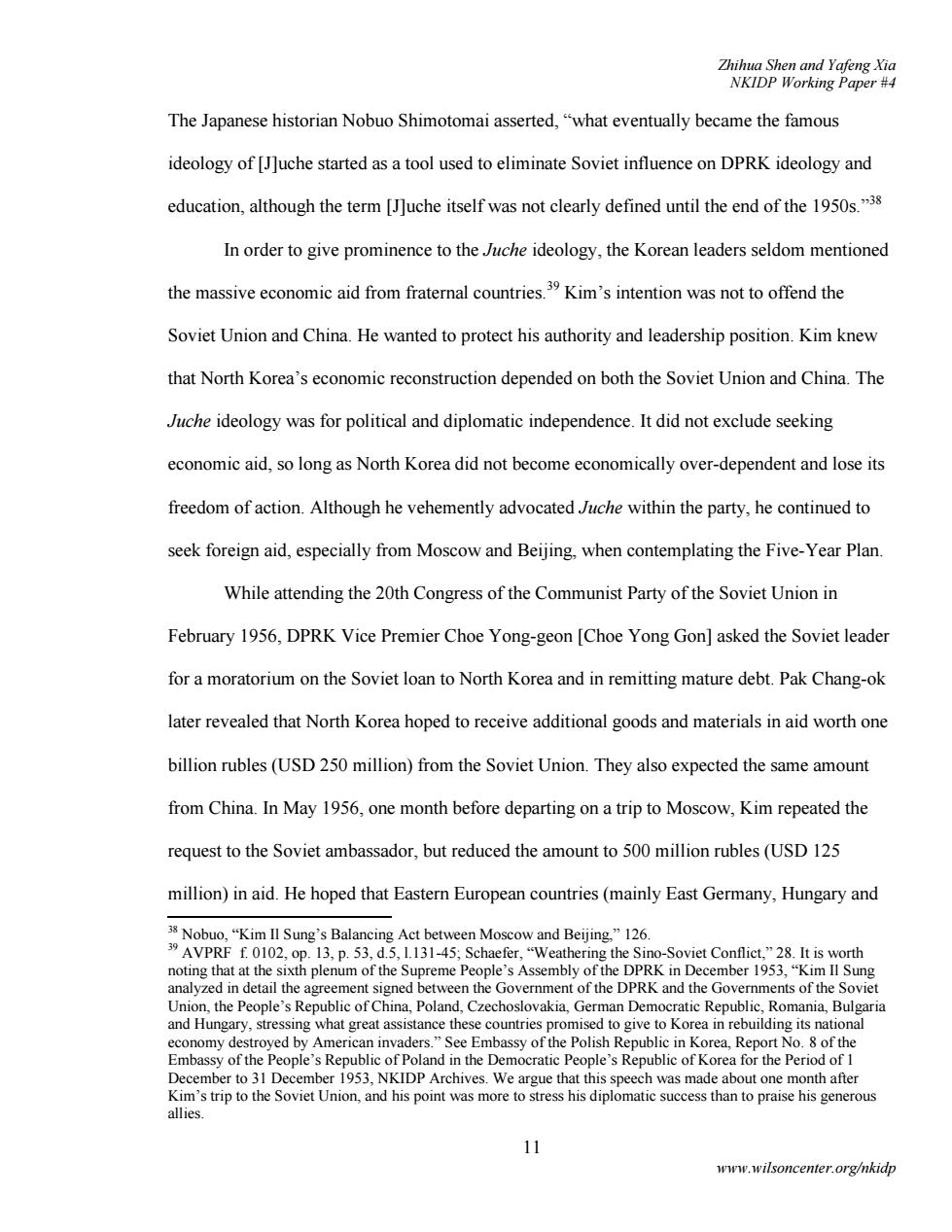
Zhihua Shen and Yafeng Xia NKIDP Working Paper #4 The Japanese historian Nobuo Shimotomai asserted,"what eventually became the famous ideology of [J]uche started as a tool used to eliminate Soviet influence on DPRK ideology and education,although the term []uche itself was not clearly defined until the end of the 1950s."38 In order to give prominence to the Juche ideology,the Korean leaders seldom mentioned the massive economic aid from fraternal countries.3 Kim's intention was not to offend the Soviet Union and China.He wanted to protect his authority and leadership position.Kim knew that North Korea's economic reconstruction depended on both the Soviet Union and China.The Juche ideology was for political and diplomatic independence.It did not exclude seeking economic aid,so long as North Korea did not become economically over-dependent and lose its freedom of action.Although he vehemently advocated Juche within the party,he continued to seek foreign aid,especially from Moscow and Beijing,when contemplating the Five-Year Plan. While attending the 20th Congress of the Communist Party of the Soviet Union in February 1956,DPRK Vice Premier Choe Yong-geon [Choe Yong Gon]asked the Soviet leader for a moratorium on the Soviet loan to North Korea and in remitting mature debt.Pak Chang-ok later revealed that North Korea hoped to receive additional goods and materials in aid worth one billion rubles(USD 250 million)from the Soviet Union.They also expected the same amount from China.In May 1956,one month before departing on a trip to Moscow,Kim repeated the request to the Soviet ambassador,but reduced the amount to 500 million rubles(USD 125 million)in aid.He hoped that Eastern European countries(mainly East Germany,Hungary and 3Nobuo,"Kim ll Sung's Balancing Act between Moscow and Beijing,"126. AVPRF f.10,op.13,p.53.d.,1.131-45;Schaefer,"Weathering the Sino-Soviet Conflict,8.It is worth noting that at the sixth plenum of the Supreme People's Assembly of the DPRK in December 1953,"Kim Il Sung analyzed in detail the agreement signed between the Government of the DPRK and the Governments of the Soviet Union,the People's Republic of China,Poland,Czechoslovakia,German Democratic Republic,Romania,Bulgaria and Hungary,stressing what great assistance these countries promised to give to Korea in rebuilding its national economy destroyed by American invaders."See Embassy of the Polish Republic in Korea,Report No.8 of the Embassy of the People's Republic of Poland in the Democratic People's Republic of Korea for the Period of 1 December to 31 December 1953,NKIDP Archives.We argue that this speech was made about one month after Kim's trip to the Soviet Union,and his point was more to stress his diplomatic success than to praise his generous allies. 11 www.wilsoncenter.org/nkidp
Zhihua Shen and Yafeng Xia NKIDP Working Paper #4 11 www.wilsoncenter.org/nkidp The Japanese historian Nobuo Shimotomai asserted, “what eventually became the famous ideology of [J]uche started as a tool used to eliminate Soviet influence on DPRK ideology and education, although the term [J]uche itself was not clearly defined until the end of the 1950s.” 38 In order to give prominence to the Juche ideology, the Korean leaders seldom mentioned the massive economic aid from fraternal countries.39 Kim’s intention was not to offend the Soviet Union and China. He wanted to protect his authority and leadership position. Kim knew that North Korea’s economic reconstruction depended on both the Soviet Union and China. The Juche ideology was for political and diplomatic independence. It did not exclude seeking economic aid, so long as North Korea did not become economically over-dependent and lose its freedom of action. Although he vehemently advocated Juche within the party, he continued to seek foreign aid, especially from Moscow and Beijing, when contemplating the Five-Year Plan. While attending the 20th Congress of the Communist Party of the Soviet Union in February 1956, DPRK Vice Premier Choe Yong-geon [Choe Yong Gon] asked the Soviet leader for a moratorium on the Soviet loan to North Korea and in remitting mature debt. Pak Chang-ok later revealed that North Korea hoped to receive additional goods and materials in aid worth one billion rubles (USD 250 million) from the Soviet Union. They also expected the same amount from China. In May 1956, one month before departing on a trip to Moscow, Kim repeated the request to the Soviet ambassador, but reduced the amount to 500 million rubles (USD 125 million) in aid. He hoped that Eastern European countries (mainly East Germany, Hungary and 38 Nobuo, “Kim Il Sung’s Balancing Act between Moscow and Beijing,” 126. 39 AVPRF f. 0102, op. 13, p. 53, d.5, l.131-45; Schaefer, “Weathering the Sino-Soviet Conflict,” 28. It is worth noting that at the sixth plenum of the Supreme People’s Assembly of the DPRK in December 1953, “Kim Il Sung analyzed in detail the agreement signed between the Government of the DPRK and the Governments of the Soviet Union, the People’s Republic of China, Poland, Czechoslovakia, German Democratic Republic, Romania, Bulgaria and Hungary, stressing what great assistance these countries promised to give to Korea in rebuilding its national economy destroyed by American invaders.” See Embassy of the Polish Republic in Korea, Report No. 8 of the Embassy of the People’s Republic of Poland in the Democratic People’s Republic of Korea for the Period of 1 December to 31 December 1953, NKIDP Archives. We argue that this speech was made about one month after Kim’s trip to the Soviet Union, and his point was more to stress his diplomatic success than to praise his generous allies